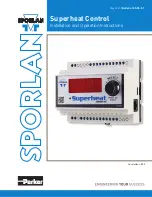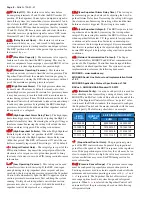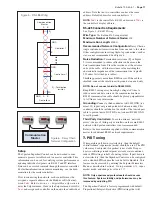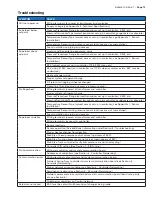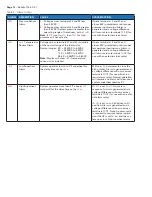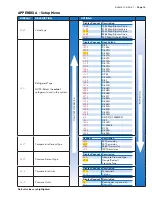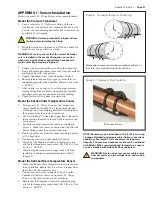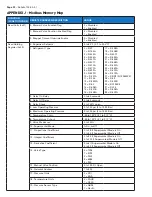
Page 8
– Bulletin 100-50-5.1
d
(Delay Off)
– This feature sets a delay time before
de-energizing terminals 19 and 20 after the EEV reaches 0%
position. If the Superheat Control gets a pumpdown signal to
shut off the system (dry contact/short across terminals 27 and
28), it closes the EEV and waits for system pumpdown by the
specified Delay Off time, then de-energizes the relay terminals
19 and 20. Delay Off time is in seconds and starts when the
controller receives a pumpdown signal or enters ‘OFF’ mode.
Terminals 19 and 20 can be used to pilot a compressor relay.
d_St
(Delay Percent Open)
– This feature is used in con-
junction with delay on,
d_n
, and is used to help equalize
system pressure prior to starting smaller, standalone systems.
The EEV position will move to the percent open position for
the time set by
d_n
.
HCP
(Max Valve Capacity)
– The maximum valve capacity
feature can be used to limit the EEV opening. This may be
used to compensate for an improper, oversized EEV. If set too
low however, system superheat may become too high.
H_P
(Maximum Operating Pressure)
– This feature can
be used on various systems to limit the suction pressure. The
Superheat Control limits the amount of suction gas going to
the compressor by closing the EEV when pressure is within 3
psi of the maximum operating pressure setpoint.
PA
(High Pressure Alarm)
– The high pressure alarm can
be deactivated. The alarm, by default, is turned on to alert
against high system pressure. For certain low pressure systems,
it may be necessary to turn this feature off to avoid nuisance
alarms during system off time. With the alarm deactivated, the
Superheat Control will still continue to take action and attempt
to reduce system pressure by regulating the EEV when high
pressure is detected. It should be noted that superheat control
takes priority as a safeguard.
5d
(High Superheat Alarm Delay Time)
- The high super-
heat alarm trigger may be delayed by adjusting the High Su-
perheat Alarm Delay time. Decreasing the setting will trigger
the alarm sooner. Increasing the setting will extend the time
before an alarm is triggered. The setting is in minutes.
5HF
(High Superheat Failsafe)
- When the High Superheat
Failsafe is placed in the ‘on’ position, the EEV will close
to 0% position after the High Superheat Alarm Delay time
(h5hd) has passed. The EEV will remain at 0% until the con-
troller is manually repowered, This setting is ‘off’ by default.
(Integral Control Gain)
– The integral gain is part of the
PID control scheme. In general the integral gain affects the
electronic valve response over a given time period to bring
the steady state error to zero. See PID tuning section for more
information.
_P
(Low Operating Pressure)
– This setting can be used
in smaller systems to aid in startup. If the EEV is not open
enough during start up (superheat above setpoint and pres-
sure below the low operating pressure setpoint) the Superheat
Control will automatically open the EEV to equalize system
suction pressure to maintain mass flow and keep the system
running. It will go back to superheat control when suction
pressure rises above
_P
setpoint. It should be noted that
superheat control takes priority as a safeguard.
Sd
(Low Superheat Alarm Delay Time)
- The low super-
heat alarm trigger may be delayed by adjusting the Low Su-
perheat Alarm Delay time. Decreasing the setting will trigger
the alarm sooner. Increasing the setting will extend the time
before an alarm is triggered. The setting is in seconds.
SH
(Low Superheat Integral)
– The EEV response to low
superheat can be adjusted by increasing the low superheat
integral. By increasing this number, the EEV will close faster
when superheat falls below 2°F. In general, if low superheat
conditions exist for more than 3 minutes in normal opera-
tion, increase the low superheat integral. It is recommended
that the low superheat integral be adjusted slightly above the
normal PID integral to help safeguard against low superheat
conditions.
net
(Network Communication Protocol)
– The Super-
heat Control offers MODBUS and BACnet communication
protocols. The Superheat Control has been designed follow-
ing industry standard specifications. For system set-up and
implementation, reference the following documents:
MODBUS – www.modbus.org
MODBUS Serial Line Protocal and Implementation Guide
v1.02
MODBUS Application Protocal Specification v1.1b3
BACnet – ANSI/ASHRAE Standard 132-2012
nPAr
(Network Parity)
– An even or odd parity bit is used for
error checking when transmitting a string of binary code via
MODBUS and BACnet. A check bit is added to the end of the
string. The Superheat Control also offers a “no parity” selec-
tion to meet the BACnet standard. It is important to configure
the Superheat Control and the master controller with the same
network parity. The following chart shows an example.
8 BITS
OF DATA
COUNT OF
“1” BITS
9 BITS INCLUDING PARITY
EVEN
ODD
00000000
0
00000000
0
00000000
1
10100010
3
10100010
1
10100010
0
11010010
4
11010010
0
11010010
1
11111110
7
11111110
1
11111110
0
P
(Proportional Control Gain)
– The proportional gain is
part of the PID control scheme. In general the proportional
gain effects the speed of the EEV in response to the superheat
error. If the proportional gain is too low, the valve may be too
slow to respond. If it is too high, the valve may overreact and
system oscillations may occur. See PID tuning section for
more information.
Prn
(Pressure Sensor Range)
– The pressure sensor range
must be configured to properly measure suction pressure.
Suction pressure is used to calculate superheat and establish a
minimum and maximum operating pressure, set by
_P
and
H_P
respectively. The Superheat Control offers several pres-
sure range options based on system design and refrigerant
pressure. When
Avt
is selected, the Superheat Control will
automatically set the pressure range based on the following
refrigerant criteria:

